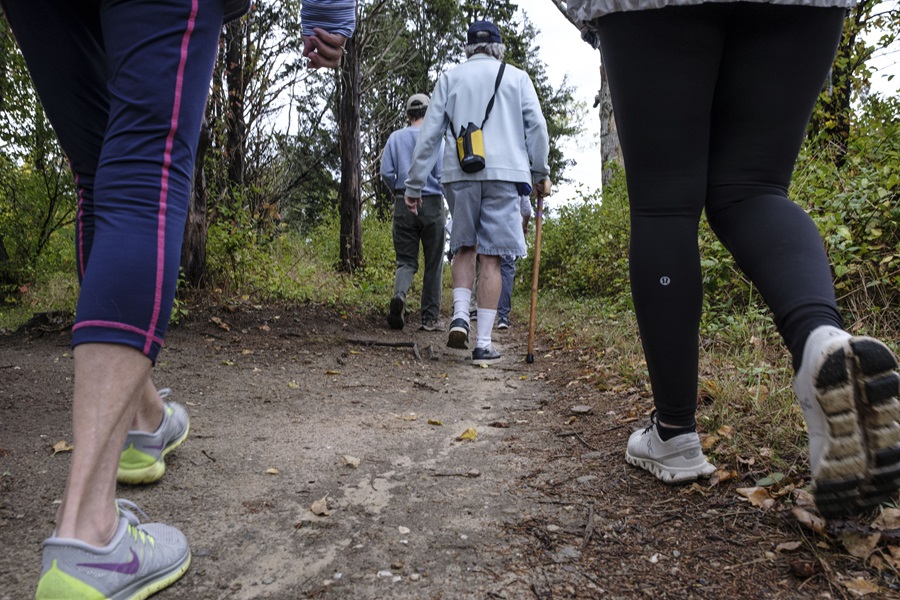EASTHAM — Jean Ehret stepped around a puddle and looked out across the rolling, recently mowed fields of Fort Hill in Eastham, which were taking on the browns and golds of progressing autumn. She paused every so often to take in the scene or open her ears to the early morning birdsong.
Ehret retired from her job at Mass Audubon’s Wellfleet Bay Wildlife Sanctuary, where she led walks and talks about birding and natural history, and now, recovering from a stroke, she said that walking is an important part of her routine.
“I like to look around and appreciate what I’m seeing — sort of a smell-the-roses thing,” said Ehret, who started visiting Eastham in 1970 and has lived here since 1994.
She wants to be able to “stop and gawk” at things. That’s why she stuck near the back of the Eastham Wellness Walking Group, which she learned about through the town’s council on aging (COA) and senior center.

Ehret was one of 10 women who met on Sept. 27 for the second gathering of the group, a joint initiative of the COA, the Eastham Health Dept., the public health division of the Cape Cod Visiting Nurse Association (VNA), and the Cape Cod National Seashore. The group is open to all Outer Cape residents 65 and over.
Dorothy Burritt, the COA’s director, first sought to create a walking program in response to findings published last year from a needs assessment for Eastham residents 50 and over. It was conducted over nine months by the Center for Social and Demographic Research on Aging at UMass Boston and collected responses from some 1,500 Eastham residents and town employees.
The assessment identified seven challenges for older people in town and produced recommendations for the COA and other town departments to better support those over 50, who compose nearly 70 percent of Eastham’s year-round population.
In addition to needs for more housing, transportation, caregiver support, and COA programming, the 2023 report underlined the need to mitigate the high risk of isolation, which increases as people get older and are living alone.
“There are features of life in Eastham that can make it easy to lose touch or self-isolate,” wrote researchers Caitlin Coyle and Beth Rouleau. “The seasonality of the local economy and the challenges of weather can make it seem desolate.”
In the survey, 36 percent of Eastham residents over 50 reported that they have in-person interactions only once a month or less.
“Especially after the pandemic, we were seeing a lot of people who were very deconditioned and had been sedentary and isolated,” said Meg Payne, the VNA’s director of public health and provider relations. “People aged drastically over a short period of time.”
“Our initiative was to promote health, social interaction, and physical activity,” said Burritt.
“We’re trying to provide programming that meets the needs of the people,” added Hillary Greenberg-Lemos, Eastham’s director of health and environment. Her department provides funding for the program through its public health contract with the VNA.

For an hour each Friday morning, a National Park Service ranger guides the walking group through Seashore trails in Eastham like Fort Hill, Nauset Marsh, Red Maple, and Doane Rock to Coast Guard Beach. All the walks are under 1.5 miles.
“I think this series, as well as other guided hikes we conduct with the public, is a confidence booster and the seed for further exploration and discovery,” said interpretive park ranger Zach Piotrowski, who guides most of the group’s walks.
“Getting outside and using our senses is what keeps us healthy, physically and spiritually,” he added.
While Piotrowski or one of his colleagues leads the way and talks about the natural and human history of the Cape, VNA health educator and communicable disease investigator Molly Ives brings up the rear and makes sure everyone sticks with the group. VNA physical therapist Kristen Siminski roves and finds pockets of one-on-one conversation with participants.
Siminski, who proposed the partnership with the Seashore, told the Independent that she also hopes to incorporate short lessons on future walks about the American College of Lifestyle Medicine’s six pillars: physical activity, nutrition, stress management, social connections, sleep, and avoidance of risky substances.
“My role is to bring awareness,” said Siminski, noting how these factors can help mitigate and treat chronic conditions like cardiovascular disease, type 2 diabetes, and obesity and decrease isolation.

Siminski started last Friday’s Fort Hill walk with information about weekly goals for physical activity. The American Heart Association recommends at least 150 minutes per week of moderate-intensity aerobic activity or 75 minutes of vigorous aerobic activity. But Siminski emphasized that any type or duration of physical activity counts.
“There is no one-size-fits-all,” said Siminski. “Ideally, it’s something that you want to do that’s fun, sustainable, and brings a little bit of joy.”
On the Fort Hill trail, the group stopped for breaks at different landmarks, including one known as the “sharpening rock,” which was once used by the Nauset people to sharpen tools. It now overlooks the reflecting pools of the fringe salt marsh extending to Coast Guard Beach.
Along the way, as the mist and dew burned off, people found their pace — some of the walkers talked and others meandered silently. There were a few who knew each other before the group started its walks on Sept. 13, but most had never met before.
For Nancy Richard, a semi-retired nurse who vacationed in Eastham as a child and has lived here since 1988, the group offers “camaraderie, socializing, and a little bit of history.” She appreciates that the walks get her outside.
As the group crested the last hill, walked down the path that passes the historic Edward Penniman house and barn, and returned to the parking lot, Joan Wall sighed happily. “This was just what I needed,” she said.
